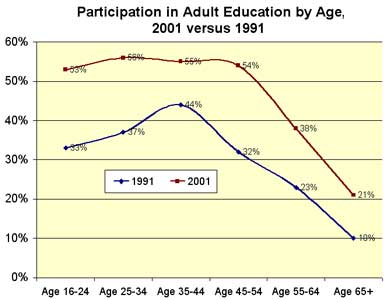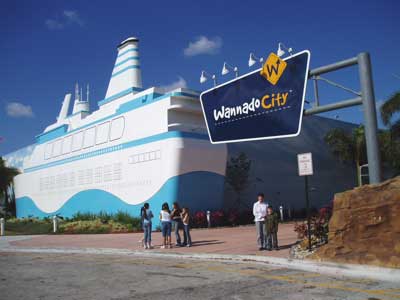Vol. V, No. 2, February / March 2005
What's happening with edutainment?
Entertainment and leisure destinations are undergoing a slow but steady change from almost pure entertainment and amusement a few decades ago to more and more edutainment - entertainment that also includes an educational or learning component. This change is being driven by a major shift in the economies and societal values of Western, Eastern European and many Asian cultures as more and more people
- are college-educated, and
- work with their brains instead of their bodies
For example, in the U.S., the percentage of workers in manufacturing jobs has decreased to 13.5% in 2000, while the number employed in managerial and professional jobs has climbed to 30%. In 2004, 60% of U.S. workers had white-collar jobs, compared with only 24% in blue-collar jobs and 16% in service and farm jobs. The number of college graduates (associate or higher degree) in 2004 had more than quadrupled since 1960 to 31% of the population 25 years and older.
We now value lifelong learning. In 2001, excluding full-time college students, 47% of U.S. adults participated in adult education. And 21% participated solely for personal interest, not for work-related reasons. The percentage of adults participating in adult education has increased dramatically in every age group.

In the manufacturing society of years past, work represented self-improvement and leisure was intended as pure relaxation, with no particular practical purpose. Today, we have an entirely new attitude about leisure. We see it as an opportunity to:
- improve ourselves and our children, and
- do worthwhile things
We now value the productive use of our leisure time. If you have any doubts, just take a look at your local cable channel listings. Edutainment shows are becoming mainstream with channels such as:
- The History Channel
- Discovery Channel
- Animal Planet
- Food Network
- National Geographic Channel
- Discovery Health Channel
- Home & Garden Television
- The Learning Channel
- Travel Channel
- Public Broadcasting Service
Research shows that this new paradigm of leisure is reflected in how Generation-X and Generation-Y parents feel about their children's use of leisure time. Baby Boomer parents tended to separate their children's playtime and learning time. Gen-X and Gen-Y parents want their children to learn as they play. This is driving the increasing market share that education toys claim in the overall toy market.
There are many types of edutainment location-based venues, from aquariums to butterfly conservatories to I-Max movie theatres. One entirely new edutainment venue category that has emerged in the last decade is children's edutainment centers. These facilities are targeted to younger children and are predominately based on pretend play and other types of children's open-ended play.
Children's edutainment center
The first type of children's edutainment center (CEdC) to evolve
was commonly called just that, a children's edutainment center.
Often for marketing purposes, they were referred to as children's
play and discovery centers or children's discovery play centers(sm).
These for-profit centers charge an admission fee, range in size from about
16,000 square feet to 25,000 square feet and are community rather than
regional in draw and often include outdoor play areas. Children must be
accompanied by parents. A farm-based variation of these evolved that included
predominately outdoor activities and had animals. These are sometimes
referred to as children's discovery farms, children's discovery
play farms or children's animal farms.
Children's edutainment on steroids
A regional form of CEdC first appeared in Mexico City, Mexico, with the
opening of Kids City (La Ciudad de los Niños) in 1999, a
68,000-square-feet role-play facility for children 4 to 12 years old.
You might think of it as a children's edutainment center on steroids.
The concept has now more than doubled in size with the recent opening
of the 150,000-square-foot Wannado City in Ft. Lauderdale, Florida.

Wannado City in Ft. Lauderdale, Florida.
To see a slide show of Wannado City, click
here.
Our company has been designing and producing children's edutainment centers since they first evolved. One of the issues we have always been challenged by is clients' desires for a model that does not require such a large size and investment. The problem with trying to shrink a children's edutainment center and still keep it a viable concept is multi-faceted:
- Centers need to be right-sized to meet what is known as the demand period, a calculation of needed capacity during the busiest times. These occur on Saturdays, when most business and birthday parties take place.
- What makes a children's edutainment center work for children is having a wide variety of play activities. Play activities and areas can be reduced in size only so much before they no longer work.
- Providing adequate parent seating takes up a large amount of space.
Stay-at-home moms' café
We have recently developed a new type CEdC that is much smaller in size
that we are calling a stay-at-home moms' café. We
have been able to reduce the size by keeping the center closed to the
general public on weekends, using it only for reserved birthday parties.
During the week, the center targets stay-at-home moms with their preschool
children. When you put in everything you need to offer moms a great experience
with a great menu of café food in a pleasant seating area and a
good variety of quality play areas for their children, the center works
out to be around 9,000 to 10,000 square feet. We have designed the model
to balance the play capacity with the number of birthday parties that
can take place simultaneously on weekends. We estimate the total development
cost will run about $1.5 million in a leased space.
The stay-at-home moms' café won't work in all markets.
It is highly dependent on a strong market of stay-at-home moms, who are
found in the highest concentrations in upper-middle and higher income
white-collar communities. To have a large enough market usually requires
the facility to be located in a well-developed suburban area of a larger
sized city.


